2011 NISSAN CUBE warning
[x] Cancel search: warningPage 23 of 345
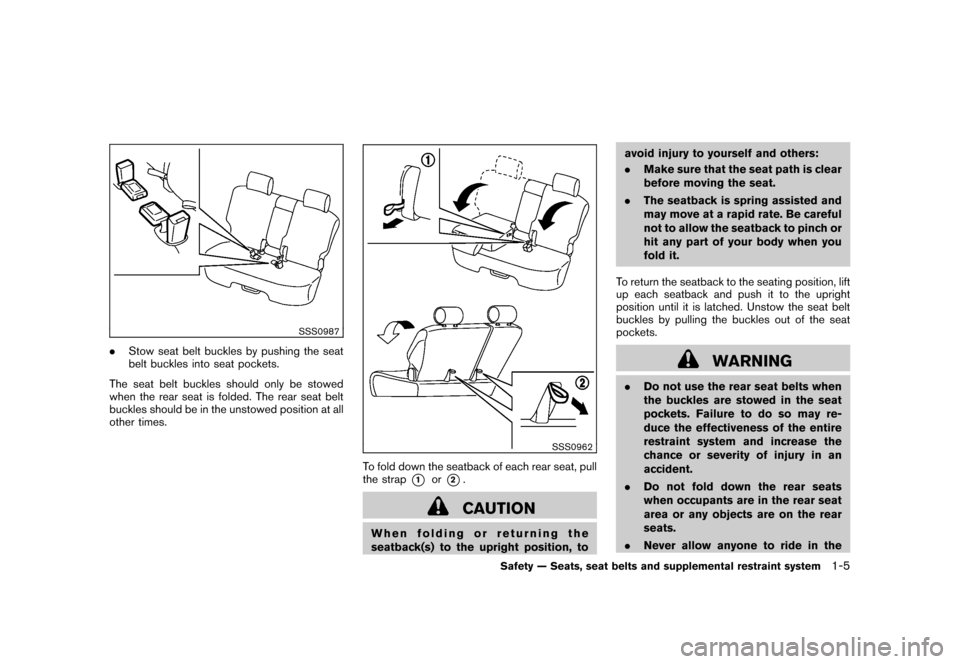
Black plate (19,1)
Model "Z12-D" EDITED: 2010/ 9/ 27
SSS0987
.Stow seat belt buckles by pushing the seat
belt buckles into seat pockets.
The seat belt buckles should only be stowed
when the rear seat is folded. The rear seat belt
buckles should be in the unstowed position at all
other times.
SSS0962
To fold down the seatback of each rear seat, pull
the strap
*1
or
*2.CAUTION
When folding or returning the
seatback(s) to the upright position, to avoid injury to yourself and others:
.
Make sure that the seat path is clear
before moving the seat.
. The seatback is spring assisted and
may move at a rapid rate. Be careful
not to allow the seatback to pinch or
hit any part of your body when you
fold it.
To return the seatback to the seating position, lift
up each seatback and push it to the upright
position until it is latched. Unstow the seat belt
buckles by pulling the buckles out of the seat
pockets.
WARNING
. Do not use the rear seat belts when
the buckles are stowed in the seat
pockets. Failure to do so may re-
duce the effectiveness of the entire
restraint system and increase the
chance or severity of injury in an
accident.
. Do not fold down the rear seats
when occupants are in the rear seat
area or any objects are on the rear
seats.
. Never allow anyone to ride in the
Safety — Seats, seat belts and supplemental restraint system
1-5
Page 24 of 345
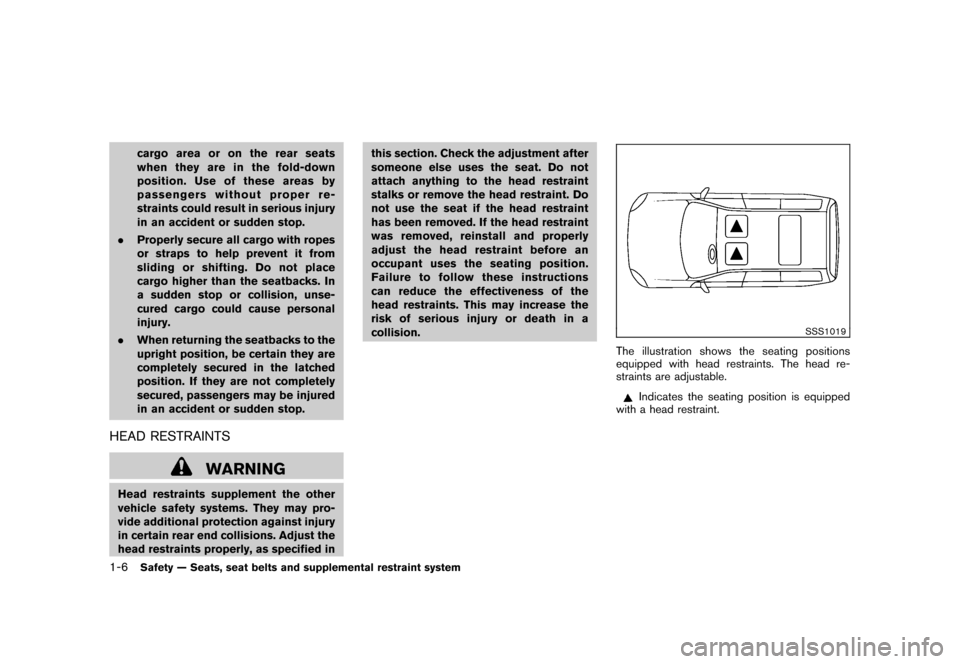
Black plate (20,1)
Model "Z12-D" EDITED: 2010/ 9/ 27
cargo area or on the rear seats
when they are in the fold-down
position. Use of these areas by
passengers without proper re-
straints could result in serious injury
in an accident or sudden stop.
. Properly secure all cargo with ropes
or straps to help prevent it from
sliding or shifting. Do not place
cargo higher than the seatbacks. In
a sudden stop or collision, unse-
cured cargo could cause personal
injury.
. When returning the seatbacks to the
upright position, be certain they are
completely secured in the latched
position. If they are not completely
secured, passengers may be injured
in an accident or sudden stop.
HEAD RESTRAINTS
WARNING
Head restraints supplement the other
vehicle safety systems. They may pro-
vide additional protection against injury
in certain rear end collisions. Adjust the
head restraints properly, as specified in this section. Check the adjustment after
someone else uses the seat. Do not
attach anything to the head restraint
stalks or remove the head restraint. Do
not use the seat if the head restraint
has been removed. If the head restraint
was removed, reinstall and properly
adjust the head restraint before an
occupant uses the seating position.
Failure to follow these instructions
can reduce the effectiveness of the
head restraints. This may increase the
risk of serious injury or death in a
collision.
SSS1019
The illustration shows the seating positions
equipped with head restraints. The head re-
straints are adjustable.
Indicates the seating position is equipped
with a head restraint.
1-6
Safety — Seats, seat belts and supplemental restraint system
Page 27 of 345
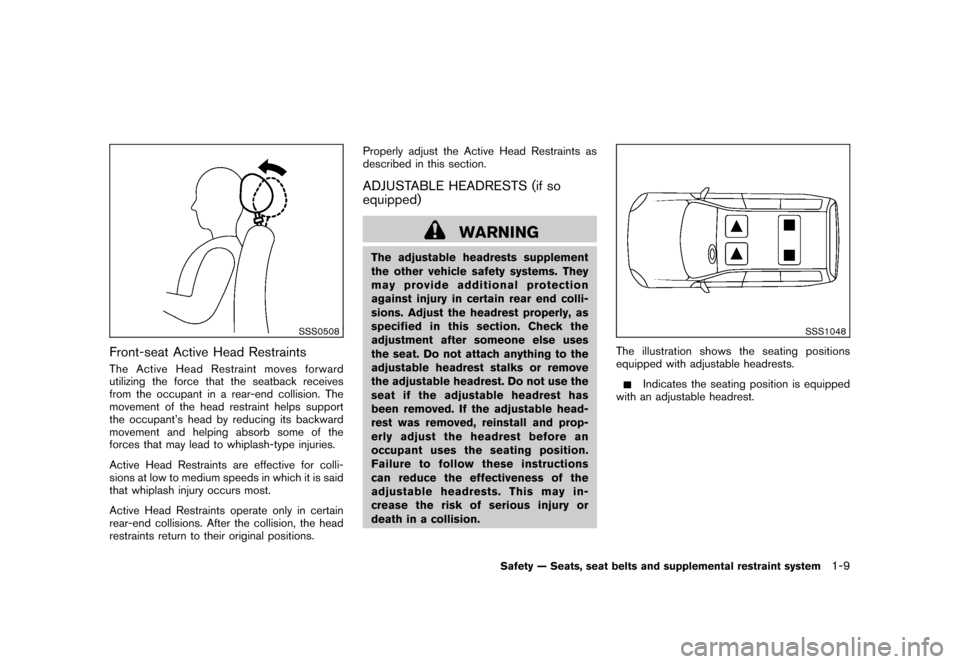
Black plate (23,1)
Model "Z12-D" EDITED: 2010/ 9/ 27
SSS0508
Front-seat Active Head RestraintsThe Active Head Restraint moves forward
utilizing the force that the seatback receives
from the occupant in a rear-end collision. The
movement of the head restraint helps support
the occupant’s head by reducing its backward
movement and helping absorb some of the
forces that may lead to whiplash-type injuries.
Active Head Restraints are effective for colli-
sions at low to medium speeds in which it is said
that whiplash injury occurs most.
Active Head Restraints operate only in certain
rear-end collisions. After the collision, the head
restraints return to their original positions.Properly adjust the Active Head Restraints as
described in this section.
ADJUSTABLE HEADRESTS (if so
equipped)
WARNING
The adjustable headrests supplement
the other vehicle safety systems. They
may provide additional protection
against injury in certain rear end colli-
sions. Adjust the headrest properly, as
specifiedinthissection.Checkthe
adjustment after someone else uses
the seat. Do not attach anything to the
adjustable headrest stalks or remove
the adjustable headrest. Do not use the
seat if the adjustable headrest has
been removed. If the adjustable head-
rest was removed, reinstall and prop-
erly adjust the headrest before an
occupant uses the seating position.
Failure to follow these instructions
can reduce the effectiveness of the
adjustable headrests. This may in-
creasetheriskofseriousinjuryor
death in a collision.
SSS1048
The illustration shows the seating positions
equipped with adjustable headrests.
Indicates the seating position is equipped
with an adjustable headrest.
Safety — Seats, seat belts and supplemental restraint system
1-9
Page 32 of 345
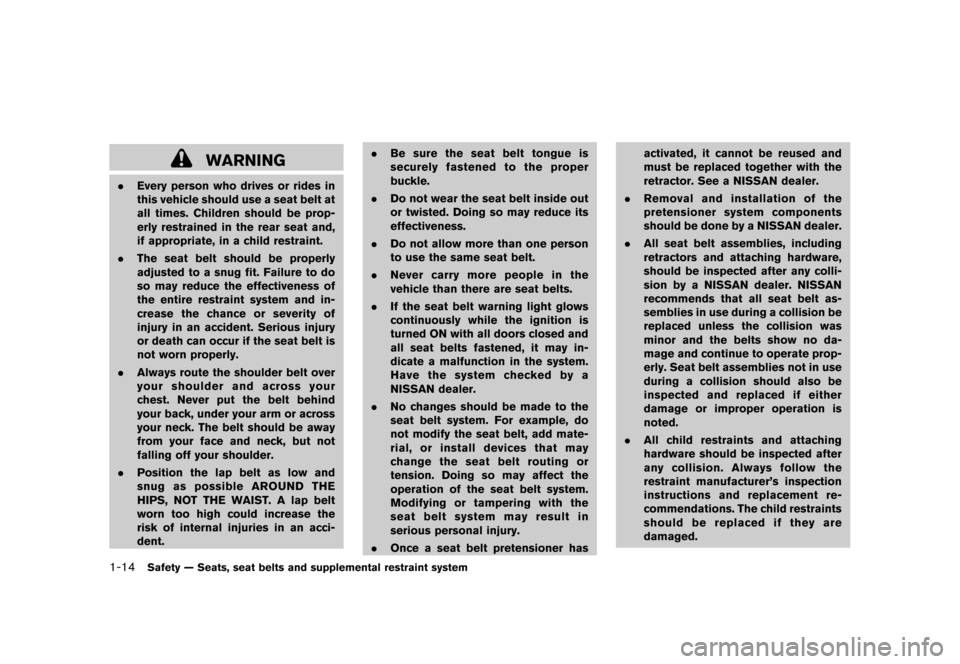
Black plate (28,1)
Model "Z12-D" EDITED: 2010/ 9/ 27
WARNING
.Every person who drives or rides in
this vehicle should use a seat belt at
all times. Children should be prop-
erly restrained in the rear seat and,
if appropriate, in a child restraint.
. The seat belt should be properly
adjusted to a snug fit. Failure to do
so may reduce the effectiveness of
the entire restraint system and in-
crease the chance or severity of
injury in an accident. Serious injury
or death can occur if the seat belt is
not worn properly.
. Always route the shoulder belt over
your shoulder and across your
chest. Never put the belt behind
your back, under your arm or across
your neck. The belt should be away
from your face and neck, but not
falling off your shoulder.
. Position the lap belt as low and
snug as possible AROUND THE
HIPS, NOT THE WAIST. A lap belt
worn too high could increase the
risk of internal injuries in an acci-
dent. .
Be sure the seat belt tongue is
securely fastened to the proper
buckle.
. Do not wear the seat belt inside out
or twisted. Doing so may reduce its
effectiveness.
. Do not allow more than one person
to use the same seat belt.
. Never carry more people in the
vehicle than there are seat belts.
. If the seat belt warning light glows
continuously while the ignition is
turned ON with all doors closed and
all seat belts fastened, it may in-
dicate a malfunction in the system.
Have the system checked by a
NISSAN dealer.
. No changes should be made to the
seat belt system. For example, do
not modify the seat belt, add mate-
rial, or install devices that may
change the seat belt routing or
tension. Doing so may affect the
operation of the seat belt system.
Modifying or tampering with the
seat belt system may result in
serious personal injury.
. Once a seat belt pretensioner has activated, it cannot be reused and
must be replaced together with the
retractor. See a NISSAN dealer.
. Removal and installation of the
pretensioner system components
should be done by a NISSAN dealer.
. All seat belt assemblies, including
retractors and attaching hardware,
should be inspected after any colli-
sion by a NISSAN dealer. NISSAN
recommends that all seat belt as-
semblies in use during a collision be
replaced unless the collision was
minor and the belts show no da-
mage and continue to operate prop-
erly. Seat belt assemblies not in use
during a collision should also be
inspected and replaced if either
damage or improper operation is
noted.
. All child restraints and attaching
hardware should be inspected after
any collision. Always follow the
restraint manufacturer’s inspection
instructions and replacement re-
commendations. The child restraints
should be replaced if they are
damaged.1-14
Safety — Seats, seat belts and supplemental restraint system
Page 33 of 345
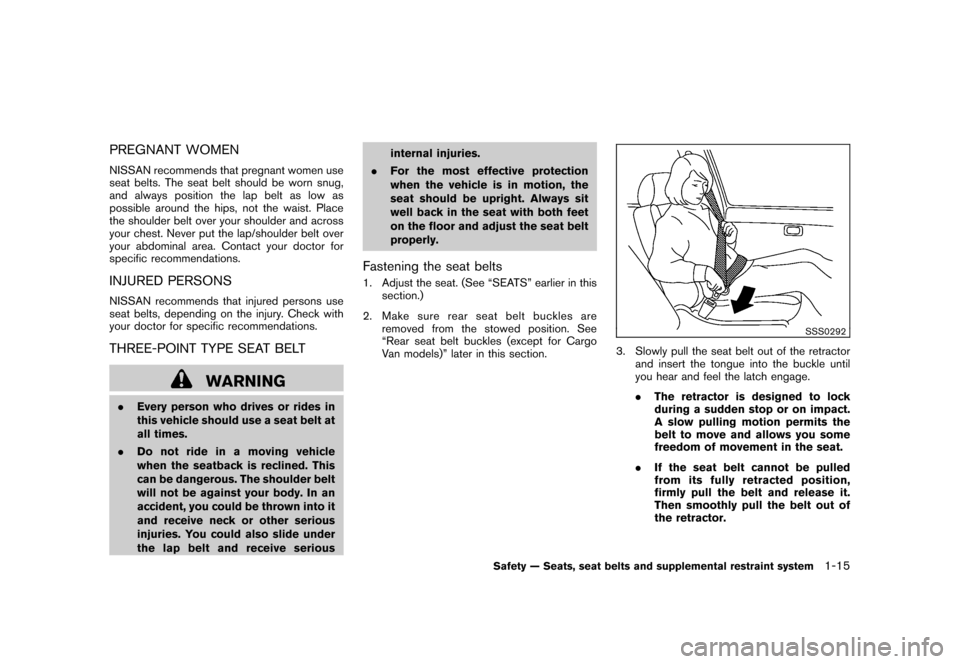
Black plate (29,1)
Model "Z12-D" EDITED: 2010/ 9/ 27
PREGNANT WOMENNISSAN recommends that pregnant women use
seat belts. The seat belt should be worn snug,
and always position the lap belt as low as
possible around the hips, not the waist. Place
the shoulder belt over your shoulder and across
your chest. Never put the lap/shoulder belt over
your abdominal area. Contact your doctor for
specific recommendations.INJURED PERSONSNISSAN recommends that injured persons use
seat belts, depending on the injury. Check with
your doctor for specific recommendations.THREE-POINT TYPE SEAT BELT
WARNING
.Every person who drives or rides in
this vehicle should use a seat belt at
all times.
. Do not ride in a moving vehicle
when the seatback is reclined. This
can be dangerous. The shoulder belt
will not be against your body. In an
accident, you could be thrown into it
and receive neck or other serious
injuries. You could also slide under
the lap belt and receive serious internal injuries.
. For the most effective protection
when the vehicle is in motion, the
seat should be upright. Always sit
well back in the seat with both feet
on the floor and adjust the seat belt
properly.
Fastening the seat belts1. Adjust the seat. (See “SEATS” earlier in this
section.)
2. Make sure rear seat belt buckles are removed from the stowed position. See
“Rear seat belt buckles (except for Cargo
Van models)” later in this section.
SSS0292
3. Slowly pull the seat belt out of the retractorand insert the tongue into the buckle until
you hear and feel the latch engage.
.The retractor is designed to lock
during a sudden stop or on impact.
A slow pulling motion permits the
belt to move and allows you some
freedom of movement in the seat.
. If the seat belt cannot be pulled
from its fully retracted position,
firmly pull the belt and release it.
Then smoothly pull the belt out of
the retractor.
Safety — Seats, seat belts and supplemental restraint system
1-15
Page 34 of 345
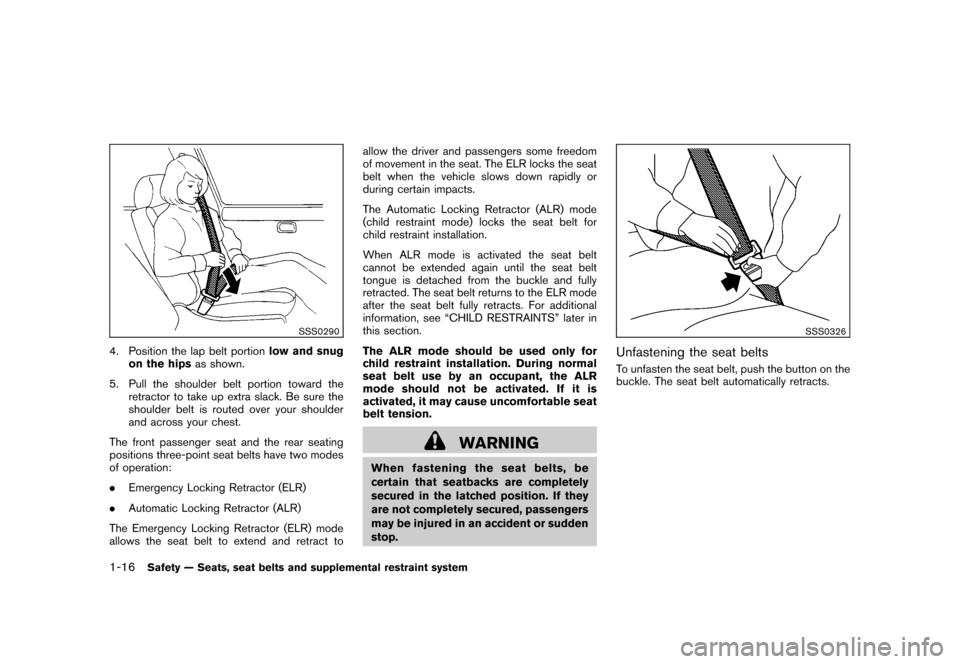
Black plate (30,1)
Model "Z12-D" EDITED: 2010/ 9/ 27
SSS0290
4. Position the lap belt portionlow and snug
on the hips as shown.
5. Pull the shoulder belt portion toward the retractor to take up extra slack. Be sure the
shoulder belt is routed over your shoulder
and across your chest.
The front passenger seat and the rear seating
positions three-point seat belts have two modes
of operation:
. Emergency Locking Retractor (ELR)
. Automatic Locking Retractor (ALR)
The Emergency Locking Retractor (ELR) mode
allows the seat belt to extend and retract to allow the driver and passengers some freedom
of movement in the seat. The ELR locks the seat
belt when the vehicle slows down rapidly or
during certain impacts.
The Automatic Locking Retractor (ALR) mode
(child restraint mode) locks the seat belt for
child restraint installation.
When ALR mode is activated the seat belt
cannot be extended again until the seat belt
tongue is detached from the buckle and fully
retracted. The seat belt returns to the ELR mode
after the seat belt fully retracts. For additional
information, see “CHILD RESTRAINTS” later in
this section.
The ALR mode should be used only for
child restraint installation. During normal
seat belt use by an occupant, the ALR
mode should not be activated. If it is
activated, it may cause uncomfortable seat
belt tension.
WARNING
When fastening the seat belts, be
certain that seatbacks are completely
secured in the latched position. If they
are not completely secured, passengers
may be injured in an accident or sudden
stop.
SSS0326
Unfastening the seat beltsTo unfasten the seat belt, push the button on the
buckle. The seat belt automatically retracts.
1-16
Safety — Seats, seat belts and supplemental restraint system
Page 35 of 345
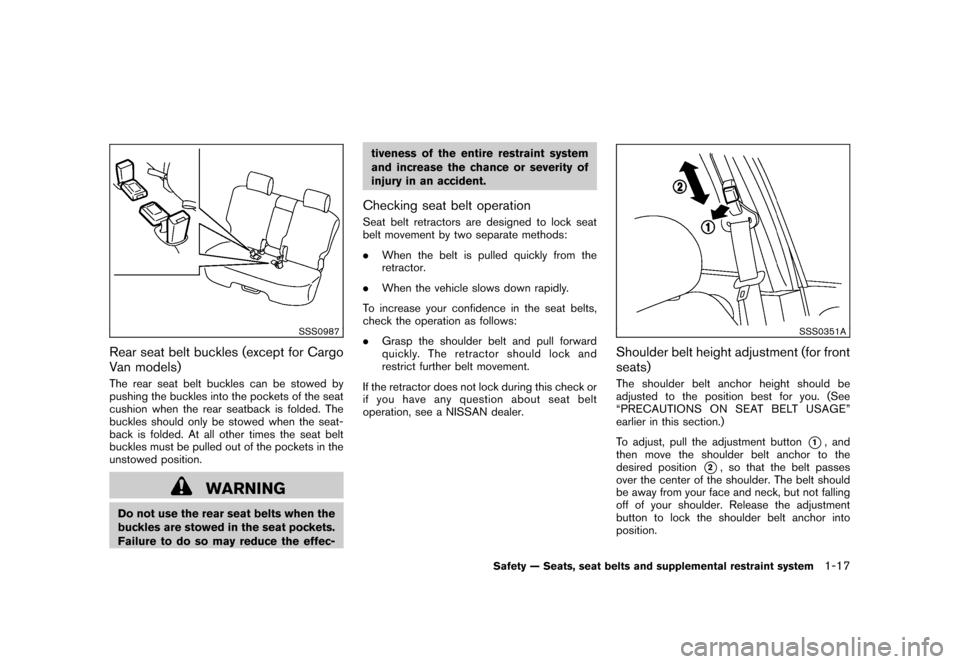
Black plate (31,1)
Model "Z12-D" EDITED: 2010/ 9/ 27
SSS0987
Rear seat belt buckles (except for Cargo
Van models)The rear seat belt buckles can be stowed by
pushing the buckles into the pockets of the seat
cushion when the rear seatback is folded. The
buckles should only be stowed when the seat-
back is folded. At all other times the seat belt
buckles must be pulled out of the pockets in the
unstowed position.
WARNING
Do not use the rear seat belts when the
buckles are stowed in the seat pockets.
Failure to do so may reduce the effec-tiveness of the entire restraint system
and increase the chance or severity of
injury in an accident.
Checking seat belt operationSeat belt retractors are designed to lock seat
belt movement by two separate methods:
.
When the belt is pulled quickly from the
retractor.
. When the vehicle slows down rapidly.
To increase your confidence in the seat belts,
check the operation as follows:
. Grasp the shoulder belt and pull forward
quickly. The retractor should lock and
restrict further belt movement.
If the retractor does not lock during this check or
if you have any question about seat belt
operation, see a NISSAN dealer.
SSS0351A
Shoulder belt height adjustment (for front
seats)The shoulder belt anchor height should be
adjusted to the position best for you. (See
“PRECAUTIONS ON SEAT BELT USAGE”
earlier in this section.)
To adjust, pull the adjustment button
*1, and
then move the shoulder belt anchor to the
desired position
*2, so that the belt passes
over the center of the shoulder. The belt should
be away from your face and neck, but not falling
off of your shoulder. Release the adjustment
button to lock the shoulder belt anchor into
position.
Safety — Seats, seat belts and supplemental restraint system
1-17
Page 36 of 345
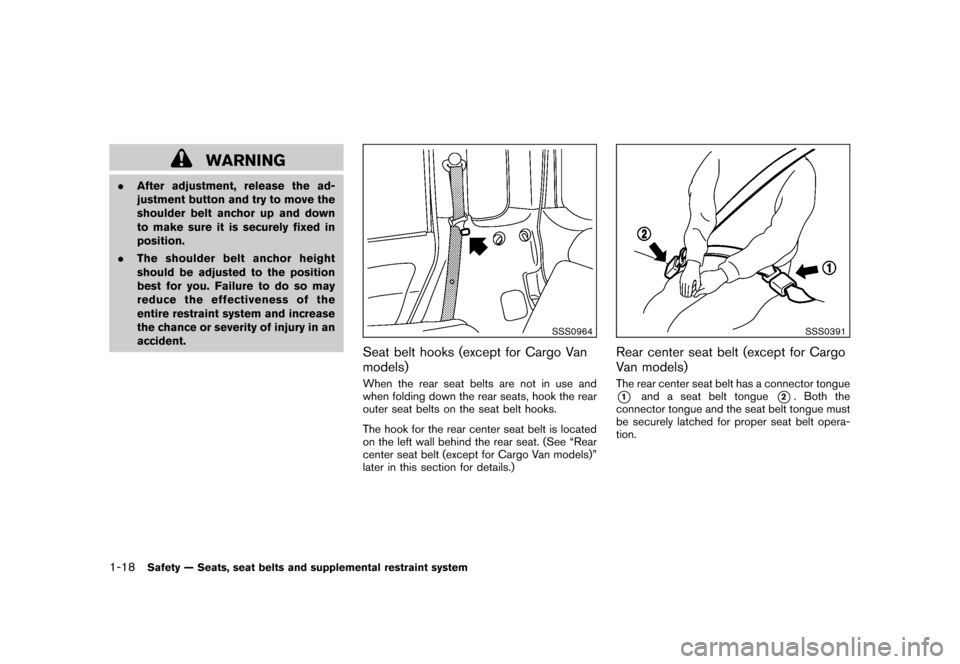
Black plate (32,1)
Model "Z12-D" EDITED: 2010/ 9/ 27
WARNING
.After adjustment, release the ad-
justment button and try to move the
shoulder belt anchor up and down
to make sure it is securely fixed in
position.
. The shoulder belt anchor height
should be adjusted to the position
best for you. Failure to do so may
reduce the effectiveness of the
entire restraint system and increase
the chance or severity of injury in an
accident.
SSS0964
Seat belt hooks (except for Cargo Van
models)When the rear seat belts are not in use and
when folding down the rear seats, hook the rear
outer seat belts on the seat belt hooks.
The hook for the rear center seat belt is located
on the left wall behind the rear seat. (See “Rear
center seat belt (except for Cargo Van models)”
later in this section for details.)
SSS0391
Rear center seat belt (except for Cargo
Van models)The rear center seat belt has a connector tongue*1
and a seat belt tongue
*2. Both the
connector tongue and the seat belt tongue must
be securely latched for proper seat belt opera-
tion.
1-18
Safety — Seats, seat belts and supplemental restraint system